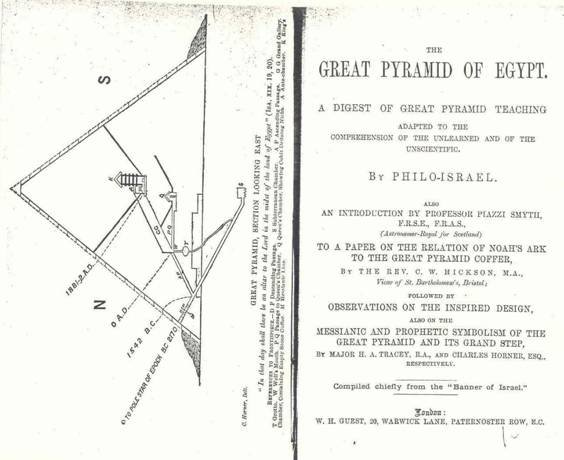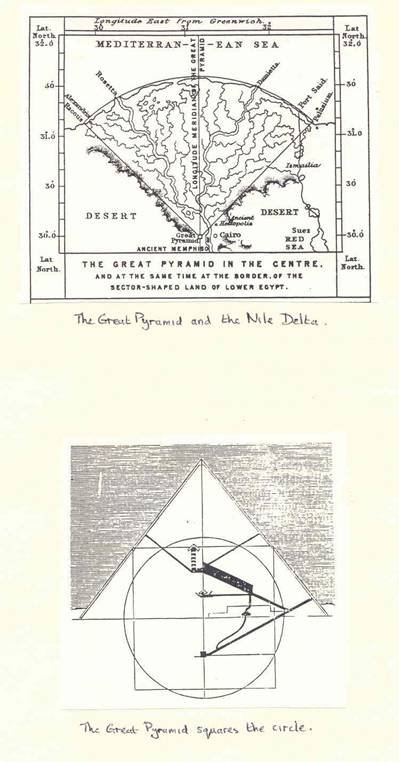
This is an excellent example of nineteenth century pyramidology, the idea being that the Great Pyramid was built under Divine Guidance to encode various scientific secrets and to act as a symbolic chronograph of world history, past and future.
Our author, Philo-Israel begins by quoting Isaiah 19.19-20, which reads thus:
“In that day there shall be an altar to the Lord in the midst of the land of Egypt, and a pillar at the border thereof to the Lord. And it shall be for a sign and for a witness unto the Lord of hosts in the land of Egypt.”
The Great Pyramid, it is argued, is both the altar and the pillar. Why? Because:
“The land of Lower Egypt is in the shape of a sector of a circle or fan. The Great Pyramid is erected at its border, and yet at the centre of the circle of which the land is a sector, or portion ‘cut out’ of a circle.”
The Great Pyramid is situated in this curious geographical location, funnily enough (see the accompanying map), but some people say that this is simply because it stands on a plateau at the head of the Nile Valley, beyond which the delta fans out. Any passing camel on the same plateau, therefore, has the same geographical property, though of course, the camel doesn’t know it, and God certainly didn’t plan it that way.

But these sceptics are such know-alls, so let us move on. Here is another geographical oddity:
“The Great Pyramid of Jeezah is situated in the very central point of all the habitable land portions of the globe. There is more land surface situated along the imaginary line running through it, North and South to the two poles of the earth, than along all the other meridional lines of longitude all round the globe.”
The sceptics don’t think much of this one either: how does one define “habitable”, for a start and what about East and West lines of Latitude? But never mind, let’s get on with the fun.
Philo-Israel, like all good pyramidologists, studies the pyramid in terms of the pyramid inch. A pyramid inch is 1.001 British Inches, and there are 25 pyramid inches to a pyramid cubit. Some people say that the pyramid inch is just a made-up measure concocted by pyramidologists to make the Great Pyramid fit their theories better, but we’ll have none of that sort of talk here, thank you very much. The fact is that if you measure up the base side of the Great Pyramid very carefully, you will get 9131.05 pyramid inches, and when expressed in pyramid cubits the result is 365.242, which is the number of days in a mean solar year, down to the third decimal place. Philo-Israel writes:
“How did the Pyramid architect know that fact unless he was Divinely inspired, seeing it was only ascertained by the learned nations of the world between 3000 and 4000 years after his day?”
Again, if you add together the lengths of the diagonals of the Great Pyramid’s base you get 25,827 pyramid inches, which is the period of the so-called precession of the equinoxes, expressed in years:
“How did the Great Pyramid architect know that number and that fact which Hipparchus, the Graecian Astronomer, is said to have first discovered many centuries after the Great Pyramid was built ?”
Next, the vertical height of the Great Pyramid, when complete (part of the top is now missing), was 5813.01 pyramid inches, a quantity which when multiplied by a thousand million gives 91,840, 000 British Miles, which is “no other than what the latest investigations at the Cape Observatory show is the exact distance of the Sun from the Earth.” So that again Philo-Israel asks:
“Could any but a Divine mind have imbedded that wondrous fact and number in the Pyramid Dimensions, man having been confessedly been yet unable to decide on it exactly?”
Kill-joy sceptics, of course, gleefully point out that the average Earth-Sun distance is now known to be just under 93,000,000 miles, and not the quantity quoted by Philo-Israel, but what is a million miles or so among pyramid friends?
As for the pyramid cubit, it is allegedly one ten-millionth part of the Earth’s polar radius. Could this be mere accident?
“Could any mere man have discovered these standard of measures or these numbers in which are embedded such wondrous physical harmonies between God’s created earth-globe for man’s home, and the architectural works of man on the same planet?”
Probably the most famous feat claimed for the Great Pyramid is the squaring of the circle. The perimeter of the base of the pyramid when divided by its height is 2π, so that the square base has a perimeter equal to that of a circle with the pyramid height as radius. The problem of constructing a square equal in perimeter to a given circle is known as squaring the circle. It was a problem posed by the Greeks, but never solved by them, or anyone after them. In 1879, when Philo-Israel was writing, the pyramidologists had some reason to be overjoyed, for it looked the pyramid architect had somehow cracked the problem. Unfortunately, in 1882, a mathematician called Lindemann proved that the problem was un-crackable, and so the pyramid architect couldn’t really have cracked it at all – it just looked like he had. Since being able to square the circle is far more exciting than anything boring old Lindemann said, I suggest we stick with the pyramid buffs, and go even further.
Inside the main chamber of the Great Pyramid (called the King’s Chamber) is a granite sarcophagus or coffer. Now:
“The cubic content of the outside of this coffer, or lidless box, is double that of its inside. This solves another ancient puzzle – the one called ‘doubling the cube.’”
Unfortunately, mathematicians have proved that you can no more duplicate the cube than you can square the circle, but never mind.
Next, we turn to the pyramid chronograph. Pyramidologists claim that the interior of the Great Pyramid symbolises the divinely appointed course of human history. Reference to the Great Pyramid cross-section facing the title page will make the idea clear enough. The entrance to the Great Pyramid represents the dispersion of Mankind at Babel in 2520 BC. Going down the Descending Passage, each pyramid inch represents a year. Marks on the walls 350 pyramid inches from the entrance thus represent the date 2170 BC, the date of erection of the Great Pyramid. The junction of the Ascending and Descending Passages represents the Exodus in 1542 BC, and the end of the Ascending Passage 0 AD, the birth of Christ. The lofty and splendid Grand Gallery symbolises the Christian Dispensation, the so-called ‘well’ 33 pyramid inches into the Grand Gallery representing AD 33, the date of the Crucifixion. The upper end of the Grand Gallery, on the same system, represents 1881 AD, a couple of years ahead of the time when Philo-Israel was writing. What the end of the Grand Gallery, and the King’s Chamber beyond, might represent, constituted “a secret yet buried in the future” for our author, but clearly exciting things were going to happen – probably the Second Coming.
The foregoing summarises Philo-Israel’s contribution to this splendid little tract. But we must not forget the Reverend Hickson’s contribution, that Noah’s Ark had a volume 100,000 times the volume of the Coffer in the King’s Chamber; nor Major H.A.Tracey’s contribution, that the volume of the Ark of the Covenant was equal to that of the Coffer. Most curious of all, though, was Mr Charles Horner’s claim that the result of the then forthcoming census of 1881 was pre-figured in the measures of the Great Pyramid. It was the height of the Grand Gallery multiplied by 100,000!